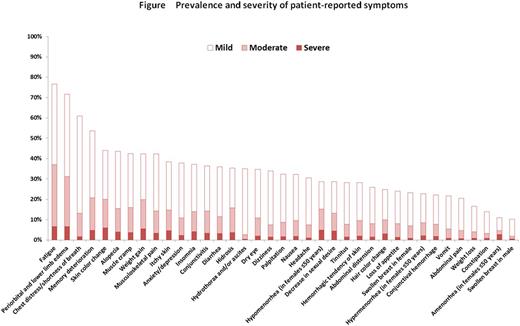Abstract
Objectives
Explore the prevalence and severity of patient-reported symptoms in patients with chronic myeloid leukemia (CML) receiving tyrosine kinase inhibitors (TKIs), and identify associated demographics and clinical variables.
Methods
A cross-sectional questionnaire, including questions assessing demographics [sex,age, household registration, marital status, education level and co-morbidity(ies)], TKI used (imatinib versus nilotinib versus dasatinib; branded drugs versus Chinese generics versus foreign generics), interval from diagnosis to starting TKI, TKI-therapy duration, therapy response [complete molecular response (CMR) versus complete cytogenetic response (CCyR) but no CMR versus no CCyR] and common patient-reported symptoms, was distributed to patients with CML in the chronic phase (CP) across China and anonymously answered. Symptoms were reported as (1) not at all; (2) mild; (3) moderate and (4) severe. Patients with CML in the CP >18 years and receiving a TKI for ≥3 months were eligible. Multivariate logistic regression model was built to identify variables associated with each symptom.
Results
Data of 1142 respondents were analyzed. 724 (63%) were male. 558 (49%) had ≥bachelor degree. Median age was 42 years (range 18-88 years). 859 (75%) were receiving imatinib, 183 (16%), nilotinib; 100 (9%), dasatinib; 761 (66%), branded drugs; 225 (20%), Chinese generics; 156 (14%), foreign generics, when they answered the questionnaire. Median TKI-therapy duration was 30 months (range, 3-192 months). 472 (41%) had achieved a CMR. The top 10 common patient-reported symptoms were fatigue (77%), periorbital and lower limb edema (72%), chest distress/shortness of breath (61%), memory deterioration (54%), skin color change (44%), alopecia (44%), muscle cramp (42%), weight gain (42%), musculoskeletal pain (42%) (Figure). In multivariate analyses, female (OR 1.5-2.7, p=<0.001-0.007), urban registration (OR 1.4-1.6, p=0.004-0.023), co-morbidity(ies) (OR 1.4-2.3, p=<0.001-0.049), interval from diagnosis to starting TKI ≥6 months (OR 1.6-1.9, p=0.013-0.016), foreign generics (OR 1.5-4.0, p=<0.001-0.027), longer therapy duration (OR 1.5-4.5, p=<0.001-0.048) were factors associated with more common and severer symptoms. Unmarried person (OR 0.2-0.7, p=<0.001-0.051), nilotinib (OR 0.1-0.7, p=<0.001-0.046), achieving a CCyR but no CMR (OR 0.5-0.8, p=<0.001-0.052) were factors associated with fewer and milder symptoms. Different ages were associated with different prevalence and severity of the symptoms. Education level ≥bachelor (OR 1.4-2.1, p=0.004-0.024) was associated with more common and severer symptoms of skin color change and hypermenorrhea (in female ≤50 years), however, fewer and milder symptom of weight gain (OR 0.76, p=0.031).
Conclusions This survey showed that demographics, current TKI used, therapy response and duration were associated with the prevalence and severity of patient-reported symptoms in patients with CML receiving TKIs. These results will contribute to making treatment decisions and improving quality of care and patients' quality of life.
No relevant conflicts of interest to declare.
Author notes
Asterisk with author names denotes non-ASH members.


This feature is available to Subscribers Only
Sign In or Create an Account Close Modal